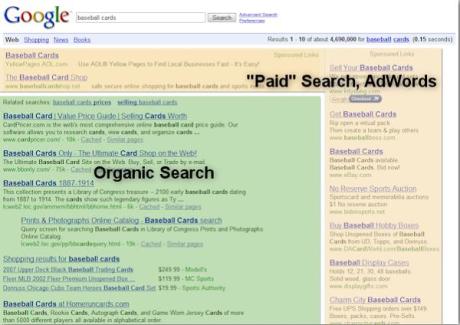To Sum it Up…
March 6, 2009
On the first day of class, everyone walked in with a different viewpoint on Social Media. There were undergrads who’ve used Facebook since middle school, young professionals who dismissed Facebook as a college phase, baby boomers who had never heard of Facebook and everyone in between. From the perspective of a young PR & Marketing here are the main points I’ve taken from this class:
- Social Media is not just for contacting your friends and can be easily applied to my career as a young PR & Marketing professional.
- Marketing is no longer about coming up with one generic message to reach everyone, but about targeting niche segments that are often underserved.
- You can use new media to directly reach consumers and get instant feeback from them.
- How to submit a press release with no “press” involved.
- The keys to blogging. The main point being your blog has to be authentic and have an authentic voice.
- The definition of SEO.
- Tags and social bookmarking are very important for SEO.
- Google has many useful resources.
- You don’t have to pay Google Adwords to advertise on Google.
- How to use Twitter
- Linkedin in a great professional networking site.
This class has been invaluable to me. I’ve always shyed away from Social Media on a personal level, but now I really appreciate it’s benefits on both a personal and professional level. I’m finally in the loop!
Attention all PR and Marketing Professionals
March 1, 2009
You have to read The New Rules of Marketing and PR by David Scott Meerman. This book teaches readers how to harness the power of New Media to reach consumers.
To get the word out about this valuable book, I submitted the following press release to www.myfreepr.com. I also bookmarked this press release on Delicous and bookmarked David Scott Meerman’s website on Digg.
Here is my press release with the details on the book:
New Book Changes the Rules of PR and Marketing
(MyFreePR) E. Lansing, MI— February 28, 2009 —The New Rules of Marketing and PR by David Meerman Scott has changed the face of PR and Marketing. The latest version of this book, released this year, instructs PR and Marketing professionals how to leverage the potential of Web-based communication to build a personal link with their target market. Scott’s book stresses that the internet has transformed the way companies communicate with consumers and the old advertising tactics don’t work online.
Publishers Weekly praised Scott’s book saying, “This excellent look at the basicis of new-millennial marketing should fine used in the hands of any serious PR professional making the transition.” In addition, Don Dunnington, president of the International Association of Online Communicators (IAOC) called The New Rules of PR and Marketing, a “revolution.”
This book is so ground breaking that Derek Mehraban, CEO Igenex Marketing and instructor at Michigan State University is using it as a text book to teach graduate PR and Advertising students for his New Media course titled New Media Driver’s License. This course, designed to create skilled and credible and young PR professionals, includes an overview of Facebook, Twitter, social bookmarking, blogging, podcasting, Google and Search Engine Optimization.
David Meerman Scott is an award winning marketing strategist, best-selling author, conference speaker and seminar leader. In addition to the New Rules of Marketing and PR, his books include: Eyeball Wars: A Novel of Dot-Com Intrigue; Cashing in with Content: How Innovative Marketers Use Digital Information to Turn Browsers into Buyers; and Tuned in: Uncover the Extraordinary Opportunities that Lead to Business Breakthroughs.
In addition to being an instructor at Michigan State University, Derek Mehraban has enjoyed a successful 15-year career as a creative marketing professional and leader in the digital marketing industry. Mehraban has amassed considerable experience leading online and offline marketing efforts for consumer products, automotive, healthcare, manufacturing, education and business-to-business clients. Mehraban is a graduate of Michigan State University, and worked for DMB&B, Campbell-Ewald, and Q LTD before founding Ingenex Digital Marketing in 2006.
The Rules of Marketing and PR Have Changed
February 21, 2009
The industry will never be the same.
As a young PR and Marketing Professional, ask yourself, what are the new rules of PR and Marketing? If you’re not sure… you need to take the New Media Driver’s License course at Michigan State University.
Designed to place students at the cutting edge of social media, this graduate level class equips PR and Marketing professionals with inside knowledge about digital PR and Marketing. 
You graduated college a few years ago, landed a great PR & Marketing job and are Internet savvy, yet you haven’t been formally trained in social media. Don’t let the latest college graduates enter the job market with all the social media know-how.
Here are some things you’ll learn in this innovative class:
- Facebook is not for students anymore–use it to your company’s advantage.
- Search Engine Optimization–advertise on Google without paying a dime.
- Blogs aren’t just for entertainment–how to blog effectively and use it to reach your target market.
- How to use Twitter and Linkedin to stay connected to your target market.
Media, PR and Marketing have already changed since you’ve earded your undergrad degree. Don’t abide by the old rules–the job market is too competitive.
The New Media Driver’s License course is taught by Derek Mehraban, CEO Ingenex Digital Marketing. This class will be offered in Spring and Fall 2009 and is an online and a 2 or 3 credit hour course.
If you’re not an MSU APPR Grad Student, you can take this class as a Lifelong Education Student.
For more information, click here.
What is Search Engine Optimization?
February 14, 2009
At first, Search Engine Optimization (SEO) for your website can be difficult to comprehend–it’s kind of complex, but it’s worth the effort of understanding. I’m going to try to break it down for the beginners, like myself.
The best way I can define SEO is “improving your website’s performance on a search engine.” The first step toward understanding SEO is to understand a search engine and the anatomy of a search. There are “organic results” and “paid search adwords.”
SEO only affects the organic results of your website (organic results are free and people are more likely to click on them versus Google AdWords). It’s a great way to be found, to get around using paid advertising, and as an added bonuse it’s a great way to help you put the “best foot” forward for your website. According to Google’s Search Engine Optimization Starter Guide the first steps to acheiving SEO for your website are:
- Create unique, accurate page titles.
- Make use of the “description” meta tag.
- Improve the structures of your URLs.
- Make your site easy to navigate.
- Offer quality content and services.
- Write better anchor text.
- Use heading tags appropriately.
- Optimize your use of images.
- Make effective use of robots.txt.
- Be aware of rel=”no follow” links.
- Promote your website in the right ways.
- Make use of free webmaster tools.
- Take advantage of web analytics services.
These are the basic starting points for SEO. These alone won’t guarentee that coveted first spot on a Google search. From here, there are many tips and tricks for further SEO. Signing up for sites like Digg and Delicious can give your page more weight and help improve your Google PageRank . Your Google PageRank is what moves your site up the Google search ladder.
These links further explain the tips/tricks for using SEO:
- http://www.thedigitalbus.com/seo-guide-basics/
- SEOMoz Free SEO tools
- SEO Basics Knol by Aaron Wall
- Google Webmaster Tools
- For an even better overview of SEO overview read The New Rules of Marketing & PR by David Meerman Scott.
For my blog page, I’m experimenting with SEO. I used most of the techniques listed above and I have signed up for Digg and Delicious. So far I have managed to get my blog on the first page of the Google search.
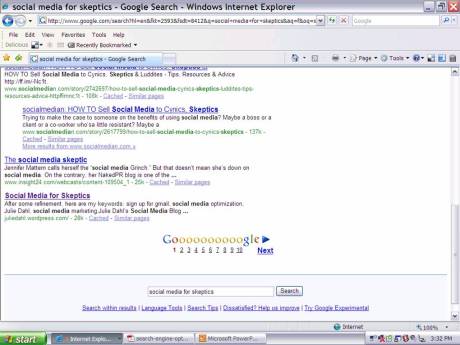
Now I just have to work on getting myself up the ladder to the first spot.
Social Media 101
February 9, 2009
I have offically signed up for three major Social Media tools: Facebook , LinkedIn and Twitter. Up until a few weeks ago, I didn’t even know what Twitter or LinkedIn were and I was contemplating taking down by Facebook page and writing it off as for college students only. I feel like I’ve been missing out on what these tools have to offer and now I’m finally in the loop.
Check out Chris Brogan’s blog about these three sites. He defines them and explains their benefits. I think I’m starting to understand this Social Media stuff. I like Twitter because it’s a short and instant way to communicate. I like LinkedIn because it’s like having a resume out there at all times–you never know what kind of opportunity that will bring. I like Facebook because the applications are useful and fun to use.
I intend to continuously build and utilize these three outposts in the future. My goals are to become more connected with other PR & Marketing professionals and to figure out the best way to use these tools to promote my hospital.
Fun with Google AdWords
January 30, 2009
Google AdWords was intimidating to use for a new user like me. When I clicked to sign up there was a ton of information to read with a bunch of new terminology. There were warnings about using the wrong keywords and not spending enough money.
So I chose my keywords, wrote my ad, set up a budget of $5.00 a month and left it for day. The next day I signed into my account expecting a bunch of impressions and clicks and my $5.00 to be gone. Instead I signed in to find big fat ZEROS. No impressions, no clicks, no money spent. So after some investigation, I changed some of my keywords and saw some impressions results.
Then I put my keywords in the traffic estimator and found out that some of the keywords I picked were very expensive ($500-$800) a day.
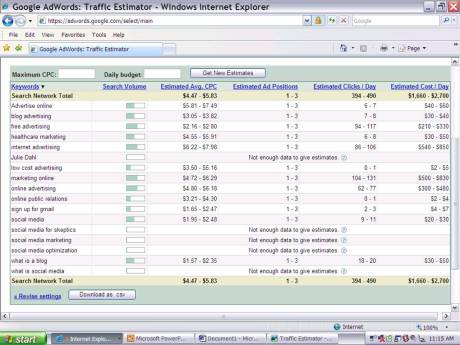
So, I further analyised at my keywords and realized they weren’t specific enough. I was using general terms like “”online advertising” when my blog is about Social Media. Because of this, I didn’t produce any impressions. I found that with a limited budget using words from my actual blog gave me more impressions. After some refinement, here are my keywords: sign up for gmail, social media optimization, Julie Dahl, social media marketing,Julie Dahl’s Social Media Blog, blog on social media, low cost advertising, online advertising, online public relations, social media, social media for skeptics, what is social media.
Currently, I have a total of 212 impressions displayed. Here’s what the impression looks like:

Now I just need someone to click on my impressions! I still haven’t received any clicks. This is where setting up a good ad and title come into play. I have changed it a couple times, but still haven’t had any clicks. I’m going to keep working on it until my $5.00 budget is spent in clicks.
All in all, Google AdWords is user friendly and fun. It’s fun to build an account and experiment with it, checking to see if you got an impression or click. But, I wonder about the return on investment on Google Adwords. It seems as though everyone is using Adwords and it’s no longer a way to stand out from the pack. I’d have to do some more investigating on ROI if I was going to use it for something other than my blog. It’s one thing to get an impression, one thing to get a click, but how many people will act on that click and generate business? If it’s just a shot in the dark, I think I’d rather try to come up on the left side of the Google page for free.
Physician Blogging
January 25, 2009
My boss and I are investigating new ways to promote and position physicians as the experts they are. To achieve this, one tactic is setting them up to blog about their specialty and clinical interests. Using Google Blog Search I found a good example of a physician blog titled The Heart Scan Blog. Cardiologist Dr. William Davis blogs about preventing heart disease. This blog gives Dr. Davis authority and sets up him as an expert in heart disease.
Dr. Davis posts topics he feels are relevant and doesn’t answer personal medical questions from the public. I think this is a good approach because a Q&A blog might be too much work and the questions from the public might be too unpredictable. He does address questions if they frequently come up in response to one of is posts.
When using Google Blog Search I was surprised that there weren’t many physician blogs on cardiology and heart disease. I hope this means there is opportunity in this arena.
Furthermore, I’m happy to learn that as a hospital marketer, I can use physician blogs in many ways. Aside from physician promotion, I can use them to find updated information and what the public considers to be “hot topics” in cardiology. For example, Dr. Davis’ blog said good dental hygiene can help prevent heart disease. I can investigate this for future newsletters.
Just Google It
January 24, 2009
Well, it looks like Google’s got me. Up until this week, I’ve never used Google for more anything other than a search engine. For my NMDL class, I investigated Gmail, Google Analytics, Google Earth, Google Groups, Google Calendar and Google Reader. I’m impressed. They all are very practical tools and FREE. I don’t believe Microsoft offers anything for free.
Since I’m new to Google, and apparently behind in the times, I have to rave about Gmail. 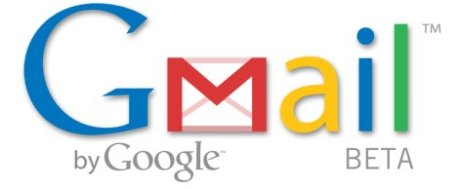 I just signed up for a Gmail account. I got the feeling from my professor, Derek Mehraban, that email addresses are trendy and that Gmail is currently the hottest one. The last email I signed up for was Yahoo in 1999, when I was a sophomore in high school. I think I’m going to like Gmail better. There are a lot of shortcuts like Quick Contacts, Keyboard Shortcuts and Gmail Search to make navigation easy. Another cool thing is Conversation View.
I just signed up for a Gmail account. I got the feeling from my professor, Derek Mehraban, that email addresses are trendy and that Gmail is currently the hottest one. The last email I signed up for was Yahoo in 1999, when I was a sophomore in high school. I think I’m going to like Gmail better. There are a lot of shortcuts like Quick Contacts, Keyboard Shortcuts and Gmail Search to make navigation easy. Another cool thing is Conversation View.
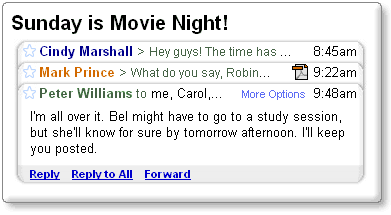
This technology allows you to set up a link for a document and then invite people to visit and review. This way you can gather all the comments on a document at once. Being in Marketing, I send out a lot of documents for review and approval. This could make my job so much easier. I can’t tell you how much time I spend retrieving and compiling comments from others.
I’m officially a Google fan.
Healthcare is different
January 18, 2009
 How do we put healthcare, the largest growing industry in the U.S., and new media together? My career is marketing a hospital to Detroit and its surrounding suburbs–I’m a little afraid to use new media.
How do we put healthcare, the largest growing industry in the U.S., and new media together? My career is marketing a hospital to Detroit and its surrounding suburbs–I’m a little afraid to use new media.
The majority of our target market is over 5o without access to email. We currently reach more people using a direct mail piece than we would with email blasts. There’s no guarentee we going to reach our target market with new media…so what’s the point?
Another issue about the use of new media in healthcare is that our customer is different. Technically, they aren’t “customers,” but patients and we have a very unique relationship with them. We don’t just sell them a product, we take care of them for life. We guide them through some of the most difficult times they’ll ever experience. It’s a very complex and sensitive relationship.
So what if we do everything right, but the patient isn’t happy? Will they tell the world through new media and give us a bad name? For example, if we didn’t refill a narcotics prescription per a healthy patient’s request. Are they going to go onto our Facebook page and bad mouth us giving others the wrong idea?
With the aging target market and the sensitive issues that arise, I wonder if healthcare is ready for new media.
There’s no stopping it….
January 10, 2009
It is amazing how the human race progresses. From the horse to the automobile, from radio to TV, from PCs to iphones–the constant evolution is endless.

Blast from the past
So here we stand in the middle of another monumentus evolution–old media to new media. Let’s face it, new media is not going anywhere and public relations & marketing will never be the same because of it. The days of newspaper ads and commmericals are fading fast…don’t get left behind with them.
The best way to approach new media to learn about it inside and out. Right now I’m in the New Media Driver’s License course at Michigan State University taught by Derek Mehraban, CEO Ingenex Digital Marketing. The goal of this class is to familiarize students with a wide variety of social networks, media tools and online technology. It took one meeting for me to become excited about new media. I am confident the things I learn in this class are going to give me the leading edge the marketing communications field and my career.
Now, more than ever, it’s time to jump on the new media bandwagon. It’s not as difficult as you think and actually fun. Don’t get stuck playing cassette tapes in a world full of ipods.

